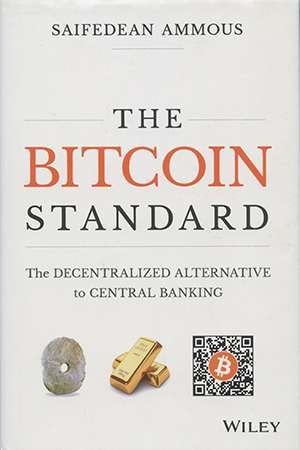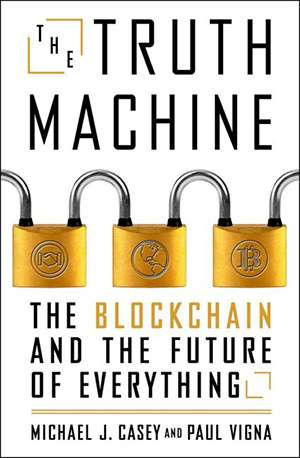Can Bitcoin Become the Global Monetary Standard?
- OurStudio

- Jul 22, 2018
- 6 min read
The Bitcoin Standard: The Decentralized Alternative to Central Banking, by Saifedean Ammous, Wiley, 286 pages, $29.95
The Truth Machine: The Blockchain and the Future of Everything, by Michael J. Casey and Paul Vigna, St. Martin's Press, 302 pages, $26.99

Wiley
If you find it hard to imagine how bitcoins could ever replace dollars as the world's primary medium of exchange, consider the bizarre tale of the donut-shaped "rai" stones on the island of Yap. Weighing up to four metric tons and standing up to 12 feet tall, these rocks couldn't be slipped into a wallet, deposited in a bank, or even moved around without enormous effort.
Yet for centuries they served the Yapese people as an effective form of money, because "the high cost of acquiring new stones" made them hard to debase, writes Saifedean Ammous in The Bitcoin Standard: The Decentralized Alternative to Central Banking. The system lasted until the 1870s, when the Irish-American ship captain David O'Keefe managed to overwhelm the island's economy with a new supply of the giant limestone discs.
It's an artful beginning to a book that makes a case for bitcoin as the best form of money ever conceived, largely because its supply is permanently capped at 21 million units. That hard limit means bitcoin can never be devalued, as were the rai stones of Yap and every other historical currency to varying degrees. Thus, it can facilitate long-term planning and investment by businesses and households.
An economist at the Lebanese American University in Beirut, Ammous earned his Ph.D. in sustainable development from Columbia. Curiously, he worked as a teaching assistant under progressive economist Jeffrey Sachs, who has called bitcoin a waste of time and resources that is destined for collapse. Ammous' résumé also lists as a reference economist Joseph Stiglitz, who has called for the U.S. to "outlaw" bitcoin.
Though written with clarity and wit, The Bitcoin Standard is not the definitive work I had hoped for: a book that thoroughly counters the best arguments of bitcoin's many detractors. It also lapses periodically into odd rants attributing all of society's alleged cultural failings—from "Miley Cyrus's twerks" to "bland, mass-produced junk food"—to government-issued money, as if financing endless wars and fueling the boom-and-bust cycle weren't enough to support his case.

St. Martin's Press
Yet the book's virtues far outweigh its faults. While the best writings on the topic can be forbidding to readers who lack a technical understanding of how bitcoin functions, Ammous has managed to produce a complex analysis that doesn't require any prerequisite knowledge.
The book begins by placing bitcoin in the context of other forms of currency. Though gold is resistant to inflation because it's so costly to mine, its "fatal flaw" compared to bitcoin is that it has to be stored in a physical location, making it vulnerable to government takeover. World War I–era inflation marked the beginning of the end for the gold standard. It was replaced by government-issued currency, which distorted the natural interest rate and turned money into "a plaything of politics," in the words of Ludwig von Mises.
Then came bitcoin. With no physical properties, this decentralized digital money isn't susceptible to state control, and its users don't need permission to spend their holdings. It's also "the hardest money ever invented," Ammous writes, since bitcoin's fixed supply of 21 million units is coded into the software. Previously it "proved impossible to come up with a form of money of which more cannot be created," which makes bitcoin the "first example of absolute scarcity." When the late economist Julian Simon observed that human time is the only truly limited resource, Ammous has quipped, he was only correct because bitcoin hadn't yet been invented.
With gold, a price increase incentivizes miners to excavate more of it. A bitcoin price increase, by contrast, attracts participants (also known as "miners") to contribute additional computing power to the network, indirectly strengthening its security. Ammous sees this as "perhaps the most ingenious aspect" of bitcoin's design.
Here the author parts company with many mainstream macroeconomists, who hold that inflation of the money supply is necessary to prevent the economy from freezing up.
The Cato Institute's George Selgin, a leading figure in the modern "free banking" school, maintains for different reasons that bitcoin's fixed supply makes it ill-suited to becoming the monetary standard. He thinks a growing labor force under a fixed supply of money would be especially problematic: Average compensation would be driven down over time, and workers would find this unacceptable.
There are strong counterarguments to this concern. Why couldn't workers adjust to a world in which their paychecks shrink, so long as their money grows in value even faster? The Bitcoin Standard would be a better book with a detailed rebuttal to free market economists like Selgin. Instead, it dismisses these objections as arising from mainstream confusion and fears.
In the last section, Ammous tackles the topic of "blockchain technology," the distributed ledger that is a core component of bitcoin. To understand the blockchain's purpose, consider the analogy of a banking ledger that's used to tabulate account holders' credits and debits. We entrust banks to keep their own ledgers. The bitcoin blockchain, in contrast, is maintained by the community at large—anyone can download a constantly updated duplicate copy. The file is constructed in a manner that prevents any existing information from being deleted or altered while allowing new data to be added. This system of decentralized recordkeeping enables the bitcoin network to operate without third-party oversight. But since it involves so much duplication and is built to contend with the security vulnerabilities that come with decentralization, it's also wildly inefficient.
It's a common refrain in the cryptocurrency community that this technology will have a bigger impact than bitcoin itself. Ammous calls this "cargo cult science," arguing that bitcoin will always be the only "successful implementation" of the blockchain. Because blockchains are so much more resource-intensive than traditional databases, use cases "need to be compelling enough to justify the extra costs."
In arguing that only bitcoin meets that high bar, Ammous overlooks some worthy projects in their early stages. One promising application is verifying that land title records in countries with insecure property rights are properly maintained and updated. Blockchains may also come to serve as a decentralized white pages—a shared virtual ledger for anchoring our digital identities. The most technically sound project in this space is Blockstack, which is attempting to use the blockchain as the foundation for a new, more open internet where users needn't rely on Facebook, Google, or other centralized platforms to manage their contacts, reputations, and data.
But if Ammous' bar for blockchain success is too high, Michael J. Casey and Paul Vigna have set theirs too low. The Truth Machine: The Blockchain and the Future of Everything sees this new form of database impacting just about every type of business. Casey, a senior advisor at the MIT Media Lab, and Vigna, a Wall Street Journal reporter, open their book by describing a pilot program for tracking food payments in the Jordanian Azraq refugee camp by scanning a refugee's iris and publishing the transactions to a blockchain. But the World Food Program, which runs the camp, has no incentive to falsify its records, so why not use a far less costly and cumbersome centralized database? Or a Google doc?
The authors' silliest claim is that a blockchain could prevent a repeat of the 2015 food-poisoning crisis at Chipotle Mexican Grill by "reasonably verify[ing] that its supplier butchers are appropriately handling the meat." They assert that "the very existence of an all-knowing ledger of activity could compel better behavior." How the existence of a blockchain would lead a well-intentioned butcher to remember to change his plastic gloves or wash his hands after a trip to the bathroom is unclear.
Casey and Vigna also imagine that blockchain technology could have stopped the collapse of Lehman Brothers by making its activities more transparent, because the 2008 financial crisis was essentially a "failure of trust" that entailed "a vast manipulation of ledgers." The authors explain that Lehman tricked regulators by keeping two sets of books, but they don't elaborate on why a decentralized public ledger would prevent chicanery of this sort. They also don't acknowledge that Lehman Brothers' financial records comprise too much data to live on a public blockchain.
As Ammous understands, bitcoin's most radical implications aren't about building a better database. They're about restoring the era of sound money, whether authorities like it or not. The best way to stop the next financial crisis is a new global standard of free market money that governments and banks can't control.




Comments